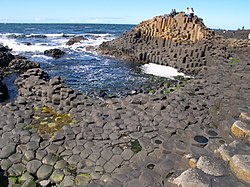| Giant's Causeway and Causeway Coast | |
|---|---|
Native names
| |
 The Giant's Causeway | |
| Location | County Antrim, Northern Ireland |
| Coordinates | 55°14′27″N 6°30′42″W / 55.24083°N 6.51167°W |
| Official name | The Giant's Causeway and Causeway Coast |
| Type | Natural |
| Criteria | (vii), (viii) |
| Designated | 1986 (10th session) |
| Reference no. | 369 |
| Region | Europe |
The Giant's Causeway (Irish: Clochán an Aifir)[1] is an area of approximately 40,000 interlocking basalt columns, the result of an ancient volcanic fissure eruption.[3][4] It is located in County Antrim on the north coast of Northern Ireland, about three miles (4.8 km) northeast of the town of Bushmills.
It was declared a World Heritage Site by UNESCO in 1986 and a national nature reserve by the Department of the Environment for Northern Ireland in 1987. In a 2005 poll of Radio Times readers, the Giant's Causeway was named the fourth-greatest natural wonder in the United Kingdom.[5]
The tops of the columns form stepping stones that lead from the cliff foot and disappear under the sea. Most of the columns are hexagonal, although some have four, five, seven, or eight sides.[6] The tallest are approximately 12 metres (39 ft) high, and the solidified lava in the cliffs is 28 metres (92 ft) thick in places.
Much of the Giant's Causeway and Causeway Coast World Heritage Site is owned and managed by the National Trust. It is one of the most popular tourist attractions in Northern Ireland,[7] receiving more than 998,000 visitors in 2019.[8] Access to the Giant's Causeway is free of charge: it is not necessary to go via the visitor centre that charges a fee.[9] The remainder of the site is owned by the Crown Estate and several private landowners.
- ^ a b "Clochán an Aifir / Giant's Causeway – Placenames Database of Ireland". Placenames Commission. Archived from the original on 8 September 2014. Retrieved 8 September 2014.
- ^ "The Crack: Yin giant step for mankind" The News Letter. Retrieved 16 October 2011.
- ^ "Giant's Causeway and Causeway Coast". UNESCO World Heritage Centre. Archived from the original on 19 January 2008. Retrieved 21 June 2009.
- ^ Jack Challoner; John Farndon; Rodney Walshaw (2004). Rocks, Minerals and the Changing Earth. Southwater. p. 19. ISBN 9781842159750. Archived from the original on 25 January 2024. Retrieved 15 May 2016.
- ^ "Caves win 'natural wonder' vote" Archived 1 August 2017 at the Wayback Machine. BBC, 2 August 2005. Retrieved 10 December 2006.
- ^ Meng, Qingxiang; Yan, Long; Chen, Yulong; Zhang, Qiang (9 November 2018). "Generation of numerical models of anisotropic columnar jointed rock mass using modified centroidal Voronoi diagrams" (PDF). Symmetry. 10 (11): 618. Bibcode:2018Symm...10..618M. doi:10.3390/sym10110618.
- ^ "Giant's Causeway remains Northern Ireland's Top Attraction" (Press release). Northern Ireland Tourist Board. 18 August 2008. Archived from the original on 14 July 2011. Retrieved 19 March 2009.
- ^ "Visits Made in 2022 to Visitor Attractions in Membership with ALVA". Association of Leading Visitor Attractions. Archived from the original on 13 April 2015. Retrieved 23 October 2020.
- ^ "Giant's Causeway: Public right of way to be protected". BBC News. 14 March 2018. Archived from the original on 30 August 2018. Retrieved 16 August 2018.
